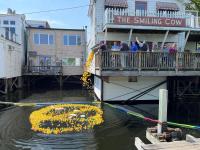Chimney creosote build-up smokes Lincolnville home
LINCOLNVILLE — Firefighters spent a good hour clearing a chimney in Lincolnville after smoke from a woodstove fire backed into, and filled, an old farmhouse on the Miller Corner Road.
While there was no fire in the chimney, firefighters attribute the excessive smoke to a build-up of creosote in the flue.
The call for help came at 9:30 p.m., Friday night, Jan. 16. Ten Lincolnville firefighters responded, and used a ball and chain to clear the chimney of the creosote, said Asst. Fire Chief Don Fullington III.
The family was awake and had evacuated the home.
Creosote, according to Hearth.com, is “a gummy, foul smelling, corrosive and extremely combustible substance that, if no precautions are taken, will coat the insides of everything it passes through. It is formed when volatile gases given off in the burning process combine and condense on their way out of the chimney.”
Creosote hardens inside chimneys, and if it builds up, can clog and cause chimney fires.
Chimney fires can accelerate and devastate a home.
According to the Chimney Safety Institute of America: “Creosote is black or brown in appearance. It can be crusty and flaky…tar-like, drippy and sticky…or shiny and hardened. Often, all forms will occur in one chimney system. Whatever form it takes, creosote is highly combustible. If it builds up in sufficient quantities — and the internal flue temperature is high enough — the result could be a chimney fire. Certain conditions encourage the buildup of creosote. Restricted air supply, unseasoned wood and, cooler than normal chimney temperatures are all factors that can accelerate the buildup of creosote on chimney flue walls.”
See more at: http://www.csia.org/homeowner-resources/the_facts_about_chimney_fires.aspx#sthash.gJWGEm3i.dpuf
Lincolnville firefighters cleared the scene just before 11 p.m.
Reach Editorial Director Lynda Clancy at lyndaclancy@penbaypilot.com; 207-706-6657
Event Date
Address
United States






















